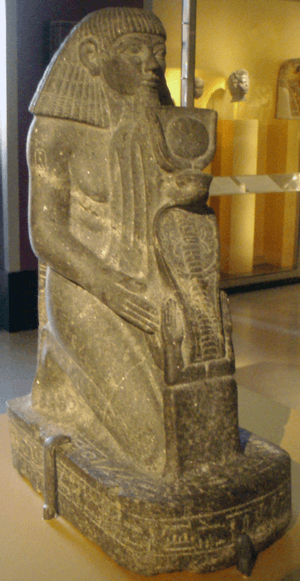Senenmut facts for kids
Quick facts for kids SenenmutHigh Steward of the King |
|
|---|---|

Statue of a Kneeling Senenmut from the Brooklyn Museum
|
|
| Dynasty | 18th Dynasty |
| Pharaoh | Hatshepsut |
| Father | Ramose |
| Mother | Hatnofer |
| Burial | TT71 |
Senenmut (Ancient Egyptian: sn-n-mwt, sometimes spelled Senmut, Senemut, or Senmout) was an important ancient Egyptian official. He lived during the 18th Dynasty, a time when Egypt was very powerful. His name means "mother's brother."
Senenmut was a very trusted advisor to Hatshepsut, who was one of the most famous female pharaohs of Egypt. He held many important jobs, showing how much Hatshepsut relied on him.
Contents
Senenmut's Important Jobs
Senenmut started his career in a humble way. He slowly rose through the ranks because of his skills and loyalty. He became one of the most powerful people in Egypt, second only to the pharaoh herself.
High Steward of the King
One of Senenmut's main titles was "High Steward of the King." This meant he was in charge of managing the pharaoh's household and her vast estates. He oversaw everything from the royal treasury to the daily needs of the palace. It was a huge responsibility, like being the chief operating officer for an entire country!
Chief Architect
Senenmut was also a brilliant architect. He was responsible for designing and building some of ancient Egypt's most amazing structures. His most famous project was the Mortuary Temple of Hatshepsut at Deir el-Bahari. This temple is a stunning example of ancient Egyptian design, carved into the cliffs.
Building the Mortuary Temple
The Mortuary Temple of Hatshepsut was a massive undertaking. It had three levels, with ramps and terraces. It was decorated with beautiful carvings and statues. Senenmut's genius helped create a monument that still impresses people today. This temple was built to honor Hatshepsut and to celebrate her reign.
Tutor to the Princess
Senenmut also had a very special role: he was the tutor to Hatshepsut's daughter, Princess Neferure. This shows how much Hatshepsut trusted him. Teaching the royal princess was a great honor and a sign of his close relationship with the royal family. Some statues even show Senenmut holding Princess Neferure.
Senenmut's Tombs
Senenmut had two tombs built for himself, which was unusual for a non-royal person. This shows his high status and wealth.
Tomb TT71
One tomb, known as TT71, is located in the area of Sheikh Abd el-Qurna. This tomb was likely meant for his burial. It has beautiful decorations that tell us about his life and beliefs.
Tomb TT353
His second tomb, TT353, is located near Hatshepsut's temple at Deir el-Bahari. This tomb is famous for its amazing astronomical ceiling. It shows constellations and planets, which tells us that ancient Egyptians had advanced knowledge of astronomy. This tomb was never fully finished or used for his burial.
Senenmut's Legacy
Senenmut's story is a great example of someone from a humble background rising to great power. He left behind a lasting legacy through the magnificent buildings he designed. His close relationship with Pharaoh Hatshepsut made him one of the most influential figures of his time. Even today, his work helps us understand the incredible achievements of ancient Egypt.
Images for kids
-
Ostracon found from the dump below Senenmut's tomb chapel (SAE 71) thought to depict his profile. Now in the Metropolitan Museum.
-
Ostracon of Senemut found from the dump below Senenmut's tomb chapel (SAE 71) thought to depict his double profile. Now in the Metropolitan Museum.
-
Ostracon found from the dump below Senenmut's tomb chapel (SAE 71) thought to depict his profile. Now in the Metropolitan Museum.
-
The only known example of a private sarcophagus made of the same stone normally reserved for royals. It is unlikely that Senenmut was ever interred in it, due to its unfinished nature. Now in the Metropolitan Museum.
-
Painted ceiling decoration from the tomb of Senenmut (SAE 71). Now in the Metropolitan Museum.
-
Painted ceiling decoration from the tomb of Senenmut (SAE 71). Now in the Metropolitan Museum.
-
Painted ceiling decoration from the tomb of Senenmut (SAE 71). Now in the Metropolitan Museum.
-
Seated Senenmut holding the princess Neferure in his arms, on display at the British Museum.
-
A kneeling statue of Senenmut, now in the Metropolitan Museum.
-
A kneeling statue of Senenmut holding a rebus of Hatshepsut's name, now in the Brooklyn Museum.
-
A block statue of Senenmut with the head of Hatshepsut's daughter Neferure appearing below his. From the Ägyptisches Museum, Berlin.
-
Statue of Senenmut and Neferura, originally from the Temple of Karnak at Thebes, now on display at the British Museum.
See also
 In Spanish: Senenmut para niños
In Spanish: Senenmut para niños
















